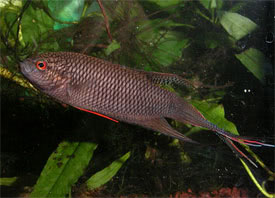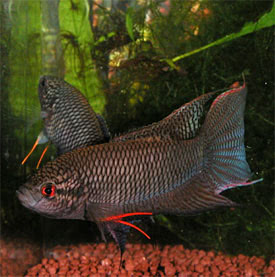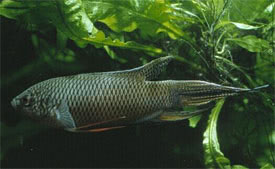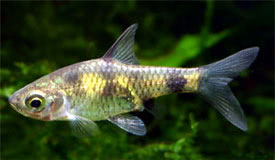
 Magyarul / Hungarian
Magyarul / Hungarian



- Scientific name: Macropodus spechti concolor
- Synonyms: Macropodus opercularis concolor
- Common name: Black paradise fish
- Group: Labyrinth fishes
- Habitat: Asia; China, Vietnam
- Size: 12 cm
- Biotope: Rivers, lakes
- Social behavior: Agressive
- Diet: All food is taken, flake, live and frozen food. Do not feed during wintertime!
- Breeding: Quite easy
- Tank: Minimum 80 litres
- Population: 1 pair for 90 litres
- Decoration: Roots and plants
- Temperature: 18-25°C
- pH: 6,5-7.
- Hardness: 5,6-8,4 NK°
- Lifespan: 5-6 years
Description: Difficult fish, requires a cold water tank with fluctuating temperatures. The fish should be kept below 12 degrees in winter , and at not too high temperatures in the summer(22-25 degrees). Prolonged periods of constant higher temperatures result in diseases like tuberculosis. Some German breeders keep this fish in ponds from spring to december, and overwinter it in the cellar. Considering that in the natural habitat the fish survive temperatures of -20 degrees(watertemp 3-4 degrees near the bottom where the fish hibernate) it can be kept in deep ponds the whole year round. Since the fish has similar natural circumstances as Northern Europe and Northern USA it may survive if introduced there, so be careful not to do that.
Increase the temperature above 20 degrees in a breeding tank(minimum 40*30*30) with neutral pH, and no current. Together with some floating plants and some hideouts for the female, weekly waterchanges, and lots of food(live) spawning behaviour can soon be observed. The male will build a small loose bubblenest at the surface below or between floating plants. The male will now darken and frequently display to the female. If she's not interested she won't change her color, and the male will chase her(Cover the tank well!!!). At a certain stage the female will be interested, and change her color to a milkish white. Below the nest the pair will mate, and the eggs will float towards the surface. The male will collect and organize the eggs under the nest, and adding bubbles to the nest while doing that. Normally 2-300 eggs are produced, but according to Jürgen Schmidt sometimes up to 800 eggs can be produced by a single female. Until the fry are free swimming the male will guard the nest. The eggs will hatch in 2 days, and after another 2-3 days the fry will be free swimming. After this the male looses interest and should be removed.















